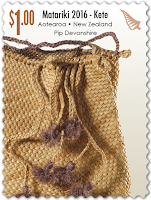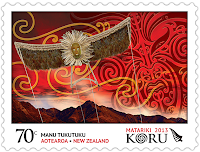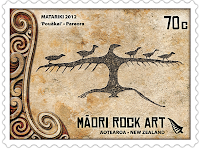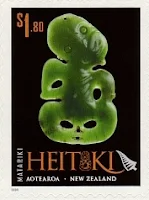Matariki
For the Māori people, the night skies in June traditionally has huge significance as the dawn of a new Māori year. The annual appearance of the seven stars of ‘Matariki’ (or the Pleiades constellation) signals a time for renewal, reflection and celebration! This celebration is something unique to New Zealand.In 2008 New Zealand Post began a series celebrating this event with a yearly stamp issue. This page is a collection of these stamp and issues with links going to more detailed posts on each issue.
For an index to all our posts on New Zealand Maori.
Please Note: - Following standard blog format, this page is laid out with the oldest at the bottom.
2017 What is Matariki?
(Not an official Matariki issue.)
$1.00 - Matariki - The Pleiades. 50c - Ranginui.
The seven stars of Matariki, also known as the Pleiades in the constellation Tauris, or by its common name 'the seven sisters'. This special post was created when it became clear there would not be a Matariki issue in 2017. The page is illustrated with the two stamps above, the only two stamps I could find that show the stars of Matariki. The post features information and background stories about Matariki.
2016 Matariki - Kete.
The practice of weaving kete, woven flax containers or baskets, has been an integral part of Maori culture for generations. Traditionally fulfilling a functional requirement, today kete have developed into a contemporary art form.
Issued to coincide with the dawn of the Māori New Year, the 2016 Matariki stamp issue examines the art form of kete; its origin, development and significance to te ao Māori (the Māori world). The six self-adhesive stamps feature six finely crafted kete, created by artists recommended by Toi Māori Aotearoa - Māori Arts New Zealand.
See our post on this issue - 2016 Matariki - Kete.
$1.00 - Pip Devonshire. $1.00 - Cori Marsters. $1.80 - Te Atiwei Ririnui.
$2.20 - Audra Potaka. $2.70 - Matthew McIntyre Wilson.
$3.30 - Sonia Snowden.
2015 Matariki - Kowhaiwhai.
Typically featured in the whare whakairo (decorated meeting house) on the heke (rafters), kōwhaiwhai is an art form that is distinctively Māori, and unique to Aotearoa New Zealand. Issued to coincide with the dawn of Māori New Year, the Matariki 2015 stamp issue celebrates this ancient art form in a contemporary setting.
This self-adhesive stamp issue displays kōwhaiwhai through the artworks of six established Māori artists - from the digital, wide-reaching work of Johnson Witehira tō the accomplished work of Sandy Adsett, who has long been regarded as the artist most closely associated with modern kōwhaiwhai painting.
See our post on this issue - 2015 Matariki - Kowhaiwhai.
80c - Johnson Witehira. 80c - Kura Te Waru Rewiri. $1.40 - Kylie Tiuka.
$2.00 - Buck Nin.
$2.50 - Ngatai Taepa. $3.00 - Sandy Adsett.
\
2014 Matariki - Papatūānuku and Ranginui.
As with many stories born from ancient folklore, there are different variations of the story of Papatūānuku and Ranginui. A widely known account tells that Ranginui, the Sky Father, and Papatūānuku, the Earth Mother, loved each other dearly and embraced so tightly that their sons were stuck in the darkness between them. Their sons decided to separate them so they could live in the light, and their son Tāne, god of humankind and forest life, pushed with all his might to force them apart. Ranginui was sent to live in the sky and Papatūānuku was sent below to live as the earth, creating Te Ao Mārama, the world of light.This stamp issue looks at this creation narrative through the eyes of six accomplished New Zealand artists, who represent parts of the narrative in their own unique ways.
See my page on this issue 2014 Matariki - Papatūānuku and Ranginui.
80c – Phil Mokaraka Berry. 80c – Cliff Whiting. $1.40 – Kura Te Waru Rewiri.
$2.00 – Fred Graham.
$2.50 – Pauline Kahurangi Yearbury. $3.00 – Robert Jahnke.
2013 Matariki - The Koru.
The koru used in many Maori patterns and designs come from the form of an emerging frond of the silver fern (see the 70c value below). Each of the six stamps in the 2013 issue incorporates the koru pattern along with aspects of traditional Māori culture that have particular significance during the time of Matariki. Maybe one of the most famous places the koru design is used is on the aircraft tails of our national airline, Air New Zealand.
70c - Manu Tukutuku. 70c - Piko.
$1.40 - Nguru. $1.90 - Pataka.
$2.40 - Kotiate. $2.90 - Patiki.
2012 Matariki - Maori Rock Art.
Although not as well known as the more famous Maori wood carvings, Maori Rock Art can be found throughout New Zealand. The examples found in this issue came from the South Island where many rock art sites have been found.
The designs were believed to have been created by applying pigment in solution to the surface of the rock creating a stain which soaks in leaving a lasting mark. The drawings depicted everyday activities or designs important to Maori culture.
70c - Pouakai, Pareora. 70c - Tiki, Maerewhenua.
$1.40 - Mokihi, Opihi. $1.90 - Te Puawaitanga.
$2.40 - Tiki, Te Ana a Wai. $2.90 - Taniwha, Opihi.
2011 Matariki - Hei Matau
(Fish hooks)
The fish hook was a very important aspect of Maori life as much of their food came from rivers, lakes or the sea. The hooks shown on these stamps feature a variety of designs and materials used for different purposes.
60c - Pounamu. 60c - Manaia. $1.20 - Inanga.
$1.90 - Te Puia $2.40 - Pukengaki. $2.90 - Tohora.
2010 Matariki - Manu Tukutuku
(Traditional Maori Kites)
The 2010 Matariki issue had 4 values depicting traditional kites. The kite, while sometimes used as a play thing by children also was important in that it represented a persons spirit as it soared into the sky before beginning its last journey.
50c - Manu Aute. $1.00 - Manu Patiki.
$1.80 - Manu Taratahi. $2.30 - Upoko Tangata.
2009 Matariki - Heitiki
The 2009 Matariki issue features the Heitiki, is an ornamental pendant of the Māori which is worn around the neck.
This issue features six examples of Heitiki past and present in a variety of materials. For more on this set of stamps, you can visit my post Heitiki - The Tiki.
See also 1958 & 1998 Pania of the Reef.
50c - Early Pounamu (Greenstone) Heitiki (Self-Adhesive).
$1.00 - South Island West Coast Pounamu Heitiki carved by Raponi (Self-Adhesive).
$1.50 - Orange Heitiki carved by Rangi Kipa (Self-Adhesive).
$1.80 - Early Kahurangi Pounamu Heitiki (Self-Adhesive).
$2.00 - 160 year old Heitiki from the collection at Te Papa Tongarewa (Self-Adhesive).
$2.30 - Paraoa (Whalebone) Heitiki carved by Rangi Hetet (Self-Adhesive).
2008 Matariki
The very first Matariki issue features six subjects of importance to Maori culture. These are very intense designs with deep spiritual meaning.
50c - Ranginui. $2.50 - Te Tau Hou.
$1.50 - Whakapapa. $2.00 - Takoha.
50c - Te Moana Nui A Kiwa. $1.00 - Papatuanuku.
2007 Southern Skies
On the 6th June, 2007 New Zealand issued a set of five values showing stunning night-sky images provided as a lovely backdrop to a set of astronomical telescopes. The timing of this set is very close to the annual rising of Matariki, with the star cluster Pleiades actually appearing on the $1.00 value, so I have decided to include this as the first stamp in my Matariki collection.
$1.00 - Matariki - The Pleiades.
The Mt John Observatory is in the foreground.























































We appreciate your engagement with our content. To ensure a respectful and constructive community, please take note of the following:
- No Spam, Please: We do not tolerate spammy or promotional comments. Any such comments will be promptly removed.
- Moderation in Place: All comments are moderated to maintain a positive and inclusive environment. Please be patient, as it may take a little time for your comment to appear.
- Sign In with Google: To comment, please sign in using your Google account. This helps us maintain the integrity of our community and allows for better interaction.